Universal Accessibility to Cultural Heritage in Spain: A Bibliometric Review
Abstract
1. Introduction
2. Materials and Methods
3. Results
3.1. Bibliometric Trends and Research Growth
3.2. Most Influential Scientific Journals
3.3. Key Authors and Their Impact on the Field
3.4. Institutional and Geographical Contributions to Research
4. Discussion
4.1. Analysis of the Most Impactful Documents and Citation Trends
4.2. Conceptual Structure Based on Keyword Analysis
4.3. Keyword Co-Occurrence Network and Thematic Clustering
4.4. Thematic Mapping of Research Domains
4.5. Classification of Technologies Applied to Accessibility in Cultural Heritage
4.6. Future Research Directions and Ethical Considerations
5. Conclusions
Supplementary Materials
Author Contributions
Funding
Data Availability Statement
Acknowledgments
Conflicts of Interest
Abbreviations
| GIS | Geographic Information Systems |
| SDG | Sustainable Development Goals |
| UK | United Kingdom |
| UN | United Nations |
References
- Ramírez-Saiz, A.; Baquero Larriva, M.T.; Jiménez Martín, D.; Alonso, A. Enhancing Urban Mobility for All: The Role of Universal Design in Supporting Social Inclusion for Older Adults and People with Disabilities. Urban Sci. 2025, 9, 46. [Google Scholar] [CrossRef]
- Convention on the Rights of Persons with Disabilities (CRPD). Available online: https://social.desa.un.org/issues/disability/crpd/convention-on-the-rights-of-persons-with-disabilities-crpd (accessed on 11 March 2025).
- Rubio-Escuderos, L.; Ullán de la Rosa, F.J.; García-Andreu, H. What Is Stopping the Process? Analysis of Obstacles to Accessible Tourism from a Stakeholders’ Perspective. J. Destin. Mark. Manag. 2025, 36, 100879. [Google Scholar] [CrossRef]
- Vecco, M. A Definition of Cultural Heritage: From the Tangible to the Intangible. J. Cult. Herit. 2010, 11, 321–324. [Google Scholar] [CrossRef]
- Gillovic, B.; McIntosh, A. Accessibility and Inclusive Tourism Development: Current State and Future Agenda. Sustainability 2020, 12, 9722. [Google Scholar] [CrossRef]
- Michopoulou, E.; Darcy, S.; Ambrose, I.; Buhalis, D. Accessible Tourism Futures: The World We Dream to Live in and the Opportunities We Hope to Have. J. Tour. Futures 2015, 1, 179–188. [Google Scholar] [CrossRef]
- Škrabi’c, B.; Peri’cperi’c, Š.; Šimundi’cšimundi’c, B.; Muštra, V.; Vugdelija, M.; Martins, J.; Št’astná, M.; Martin, J. The Role of UNESCO Cultural Heritage and Cultural Sector in Tourism Development: The Case of EU Countries. Sustainability 2021, 13, 5473. [Google Scholar] [CrossRef]
- WHO Global Report on Health Equity for Persons with Disabilities Executive Summary; WHO Press: Geneva, Switzerland, 2022; p. 312.
- Mindell, J.S.; Mackett, R.L.; Yaffe, S.; Amin, S. A Meta-Review of Literature Reviews of Disability, Travel and Inequalities. J. Transp. Health 2025, 41, 101961. [Google Scholar] [CrossRef]
- Persson, H.; Åhman, H.; Yngling, A.A.; Gulliksen, J. Universal Design, Inclusive Design, Accessible Design, Design for All: Different Concepts—One Goal? On the Concept of Accessibility—Historical, Methodological and Philosophical Aspects. Univers. Access Inf. Soc. 2015, 14, 505–526. [Google Scholar] [CrossRef]
- Reyes-García, M.E.; Criado-García, F.; Camúñez-Ruíz, J.A.; Casado-Pérez, M. Accessibility to Cultural Tourism: The Case of the Major Museums in the City of Seville. Sustainability 2021, 13, 3432. [Google Scholar] [CrossRef]
- Wang, H.; Gao, Z.; Zhang, X.; Du, J.; Xu, Y.; Wang, Z. Gamifying Cultural Heritage: Exploring the Potential of Immersive Virtual Exhibitions. Telemat. Inform. Rep. 2024, 15, 100150. [Google Scholar] [CrossRef]
- Komianos, V.; Tsipis, A.; Kontopanagou, K. Introducing Digitized Cultural Heritage to Wider Audiences by Employing Virtual and Augmented Reality Experiences: The Case of the v-Corfu Project. Technologies 2024, 12, 196. [Google Scholar] [CrossRef]
- UNE standard UNE 170001-1:2007. Universal Accessibility. Part 1: MGLC Criteria to Facilitate Accessibility to the Environment. Available online: https://www.une.org/encuentra-tu-norma/busca-tu-norma/norma?c=N0040254 (accessed on 9 April 2025).
- Spanish Government Law 16/1985, of June 25, on the Spanish Historical Heritage. Available online: https://www.boe.es/buscar/act.php?id=BOE-A-1985-12534 (accessed on 8 April 2025).
- Spanish Government Law 8/2013, of 26 June, Urban Rehabilitation, Regeneration And Renewal. Available online: https://www.boe.es/buscar/act.php?id=BOE-A-2013-6938 (accessed on 8 April 2025).
- Ministry of Social Rights and Agenda 2030. Second National Plan for Universal Accessibility. Spain, an Accessible Country. Available online: https://www.rpdiscapacidad.gob.es/estudios-publicaciones/Plan-Nacional-Accesibilidad.htm (accessed on 9 April 2025).
- Martínez-Graña, A.M.; Goy, J.L.; González-Delgado, J.Á.; Cruz, R.; Sanz, J.; Cimarra, C.; de Bustamante, I. 3D Virtual Itinerary in the Geological Heritage from Natural Areas in Salamanca-Ávila-Cáceres, Spain. Sustainability 2018, 11, 144. [Google Scholar] [CrossRef]
- Santos-Iglesia, C.; Fernández-Arias, P.; Antón-Sancho, Á.; Vergara, D. Energy Consumption of the Urban Transport Fleet in UNESCO World Heritage Sites: A Case Study of Ávila (Spain). Sustainability 2022, 14, 5641. [Google Scholar] [CrossRef]
- López-Bravo, C. Towards Transdisciplinary Heritage Assessment: An Analysis of the Use of Landscape Study Methods as a Holistic Toolbox for Cultural Site Characterisation in the Spanish Context. Architecture 2024, 4, 197–220. [Google Scholar] [CrossRef]
- Curado, M.; Rodriguez, R.; Jimenez, M.; Tortosa, L.; Vicent, J.F. A New Methodology to Study Street Accessibility: A Case Study of Avila (Spain). ISPRS Int. J. Geoinf. 2021, 10, 491. [Google Scholar] [CrossRef]
- Marín-Nicolás, J.; Sáez-Pérez, M.P.; Tajani, F.; Sica, F. Analysis of the Accessibility Improvement Index in Urban Areas through Heritage Buildings Used as Museums—Case Studies in the Region of Murcia (Spain). Sustainability 2023, 15, 13517. [Google Scholar] [CrossRef]
- Spanish Association for Standardization. UNE 41531:2018: Accessibility to Cultural Heritage. Criteria for Project Development. Available online: https://www.une.org/encuentra-tu-norma/busca-tu-norma/norma?c=N0060417 (accessed on 7 April 2025).
- European Commission Directive (EU) 2024/2841 of the European Parliament and of the Council of 23 October 2024 Establishing the European Disability Card and the European Parking Card for Persons with Disabilities. Available online: https://eur-lex.europa.eu/legal-content/EN/TXT/?uri=OJ:L_202402841 (accessed on 7 April 2025).
- European Commission Access City Award: For Cities That Are Accessible to All. Available online: https://commission.europa.eu/strategy-and-policy/policies/justice-and-fundamental-rights/disability/access-city-award_en (accessed on 7 April 2025).
- Horizon 2020 Project ARCHES EN—Accessible Resources for Cultural Heritage EcoSystems. Available online: https://www.arches-project.eu/ (accessed on 7 April 2025).
- INTERREG CENTRAL EUROPE COME-IN!—Cooperating for Open Access to Museums—Towards Wider Inclusion. Available online: https://programme2014-20.interreg-central.eu/Content.Node/COME-IN.html (accessed on 7 April 2025).
- Spanish Ministry of Culture Statistical Exploitation of the Cultural Heritage Database. Available online: https://www.cultura.gob.es/servicios-al-ciudadano/estadisticas/cultura/mc/culturabase/patrimonio/resultados-patrimonio.html (accessed on 7 April 2025).
- Haddaway, N.R.; Page, M.J.; Pritchard, C.C.; McGuinness, L.A. PRISMA2020: An R Package and Shiny App for Producing PRISMA 2020-Compliant Flow Diagrams, with Interactivity for Optimised Digital Transparency and Open Synthesis. Campbell Syst. Rev. 2022, 18, e1230. [Google Scholar] [CrossRef]
- Regona, M.; Yigitcanlar, T.; Xia, B.; Li, R.Y.M. Opportunities and Adoption Challenges of AI in the Construction Industry: A PRISMA Review. J. Open Innov.: Technol. Mark. Complex. 2022, 8, 45. [Google Scholar] [CrossRef]
- Page, M.J.; McKenzie, J.E.; Bossuyt, P.M.; Boutron, I.; Hoffmann, T.C.; Mulrow, C.D.; Shamseer, L.; Tetzlaff, J.M.; Akl, E.A.; Brennan, S.E.; et al. The PRISMA 2020 Statement: An Updated Guideline for Reporting Systematic Reviews. Int. J. Surg. 2021, 88, 105906. [Google Scholar] [CrossRef]
- del Bosque, A.; Lampropoulos, G.; Vergara, D. Nanocomposites for Multifunctional Sensors: A Comprehensive Bibliometric Exploration. Nanomaterials 2024, 15, 34. [Google Scholar] [CrossRef]
- del Bosque, A.; Fernández-Arias, P.; Vergara, D. Titanium Additive Manufacturing with Powder Bed Fusion: A Bibliometric Perspective. Appl. Sci. 2024, 14, 10543. [Google Scholar] [CrossRef]
- Aria, M.; Cuccurullo, C. Bibliometrix: An R-Tool for Comprehensive Science Mapping Analysis. J. Inf. 2017, 11, 959–975. [Google Scholar] [CrossRef]
- Linnenluecke, M.K.; Marrone, M.; Singh, A.K. Conducting Systematic Literature Reviews and Bibliometric Analyses. Aust. J. Manag. 2020, 45, 175–194. [Google Scholar] [CrossRef]
- Su, X.; Li, X.; Kang, Y. A Bibliometric Analysis of Research on Intangible Cultural Heritage Using CiteSpace. Sage Open 2019, 9, 1–18. [Google Scholar] [CrossRef]
- Tang, Y.; Liu, L.; Pan, T.; Wu, Z. A Bibliometric Analysis of Cultural Heritage Visualisation Based on Web of Science from 1998 to 2023: A Literature Overview. Humanit. Soc. Sci. Commun. 2024, 11, 1–11. [Google Scholar] [CrossRef]
- Kim, J.; Jovanovi’c, A.J.; Milosavljevi’c, A.M. VoRtex Metaverse Platform for Gamified Collaborative Learning. Electronics 2022, 11, 317. [Google Scholar] [CrossRef]
- Palomo, I. Climate Change Impacts on Ecosystem Services in High Mountain Areas: A Literature Review. Mt. Res. Dev. 2017, 37, 179–187. [Google Scholar] [CrossRef]
- Savoldi, B.; Gaido, M.; Bentivogli, L.; Negri, M.; Turchi, M. Gender Bias in Machine Translation. Trans. Assoc. Comput. Linguist. 2021, 9, 845–874. [Google Scholar] [CrossRef]
- Gao, J.; Huang, Z.; Zhang, C. Tourists’ Perceptions of Responsibility: An Application of Norm-Activation Theory. J. Sustain. Tour. 2017, 25, 276–291. [Google Scholar] [CrossRef]
- Fenu, C.; Pittarello, F. Svevo Tour: The Design and the Experimentation of an Augmented Reality Application for Engaging Visitors of a Literary Museum. Int. J. Hum. Comput. Stud. 2018, 114, 20–35. [Google Scholar] [CrossRef]
- da Costa Liberato, P.M.; Alén-González, E.; de Azevedo Liberato, D.F.V. Digital Technology in a Smart Tourist Destination: The Case of Porto. J. Urban Technol. 2018, 25, 75–97. [Google Scholar] [CrossRef]
- Mesquita, S.; Carneiro, M.J. Accessibility of European Museums to Visitors with Visual Impairments. Disabil. Soc. 2016, 31, 373–388. [Google Scholar] [CrossRef]
- Hou, Y.; Kenderdine, S.; Picca, D.; Egloff, M.; Adamou, A. Digitizing Intangible Cultural Heritage Embodied: State of the Art. J. Comput. Cult. Herit. (JOCCH) 2022, 15, 1–20. [Google Scholar] [CrossRef]
- Herrero-Prieto, L.C.; Gómez-Vega, M. Cultural Resources as a Factor in Cultural Tourism Attraction: Technical Efficiency Estimation of Regional Destinations in Spain. Tour. Econ. 2017, 23, 260–280. [Google Scholar] [CrossRef]
- Lizama, L.; Herrera, I.; Kanungo, A.K.; Lerario, A. The Role of Built Heritage for Sustainable Development Goals: From Statement to Action. Heritage 2022, 5, 2444–2463. [Google Scholar] [CrossRef]
- Beccarello, M.; Di Foggia, G. Sustainable Development Goals Data-Driven Local Policy: Focus on SDG 11 and SDG 12. Adm. Sci. 2022, 12, 167. [Google Scholar] [CrossRef]
- Ruiz Pulpón, Á.R.; del Carmen Cañizares Ruiz, M. Enhancing the Territorial Heritage of Declining Rural Areas in Spain: Towards Integrating Top-Down and Bottom-Up Approaches. Land 2020, 9, 216. [Google Scholar] [CrossRef]
- Bernabeu-Bautista, Á.; Serrano-Estrada, L.; Martí, P. The Role of Successful Public Spaces in Historic Centres. Insights from Social Media Data. Cities 2023, 137, 104337. [Google Scholar] [CrossRef]
- Sánchez-Martín, J.M.; Gurría-Gascón, J.L.; García-Berzosa, M.J. The Cultural Heritage and the Shaping of Tourist Itineraries in Rural Areas: The Case of Historical Ensembles of Extremadura, Spain. ISPRS Int. J. Geoinf. 2020, 9, 200. [Google Scholar] [CrossRef]
- Hu, H.; Hewitt, R.J. Future Climate Risks to World Cultural Heritage Sites in Spain: A Systematic Analysis Based on Shared Socioeconomic Pathways. Int. J. Disaster Risk Reduct. 2024, 113, 104855. [Google Scholar] [CrossRef]
- Moreno-Luna, L.; Robina-Ramírez, R.; Sánchez, M.S.O.; Castro-Serrano, J. Tourism and Sustainability in Times of COVID-19: The Case of Spain. Int. J. Env. Res. Public Health 2021, 18, 1859. [Google Scholar] [CrossRef] [PubMed]
- Blancas, F.J.; Lozano-Oyola, M.; González, M.; Guerrero, F.M.; Caballero, R. How to Use Sustainability Indicators for Tourism Planning: The Case of Rural Tourism in Andalusia (Spain). Sci. Total Environ. 2011, 412–413, 28–45. [Google Scholar] [CrossRef]
- Jelinčić, D.A.; Šveb, M. Financial Sustainability of Cultural Heritage: A Review of Crowdfunding in Europe. J. Risk Financ. Manag. 2021, 14, 101. [Google Scholar] [CrossRef]
- Goffi, G.; Cucculelli, M.; Masiero, L. Fostering Tourism Destination Competitiveness in Developing Countries: The Role of Sustainability. J. Clean. Prod. 2019, 209, 101–115. [Google Scholar] [CrossRef]
- Wan, Y.K.P. Accessibility of Tourist Signage at Heritage Sites: An Application of the Universal Design Principles. Tour. Recreat. Res. 2024, 49, 757–771. [Google Scholar] [CrossRef]
- García-Almedia, D.J.; Gartner, W.C. A Model of Competitiveness in Intangible Cultural Heritage Tourism Destinations From the Knowledge-Based View. Acta Tur. 2021, 33, 7–37. [Google Scholar] [CrossRef]
- Hidalgo-Sánchez, F.M.; Mascort-Albea, E.J.; Kada, M.; Romero-Hernández, R.; Canivell, J.; López-Larrínaga, F. 3D GIS Semi-Automatized Modelling Procedure for the Conservation of the PHiM: Heritage Municipal Buildings of Seville (Spain). A New Dimension for Urban Cultural Data Management. J. Comput. Cult. Herit. 2022, 15, 1–25. [Google Scholar] [CrossRef]
- Sedano-Espejo, E.; Mackinlay, P.; Sanz-Arauz, D.; Sánchez-Aparicio, M.; Sánchez-Aparicio, L.J. Use of Geographical Information System Approaches for the Diagnosis of San Isidoro Ruins (Madrid, Spain). Int. Arch. Photogramm. Remote Sens. Spat. Inf. Sci. 2021, XLVI-M-1–2021, 677–684. [Google Scholar] [CrossRef]
- Pisoni, G.; Díaz-Rodríguez, N.; Gijlers, H.; Tonolli, L. Human-Centered Artificial Intelligence for Designing Accessible Cultural Heritage. Appl. Sci. 2021, 11, 870. [Google Scholar] [CrossRef]
- Kosmas, P.; Galanakis, G.; Constantinou, V.; Drossis, G.; Christofi, M.; Klironomos, I.; Zaphiris, P.; Antona, M.; Stephanidis, C. Enhancing Accessibility in Cultural Heritage Environments: Considerations for Social Computing. Univers. Access Inf. Soc. 2020, 19, 471–482. [Google Scholar] [CrossRef]
- Parga Dans, E.; Alonso González, P. The Unethical Enterprise of the Past: Lessons from the Collapse of Archaeological Heritage Management in Spain. J. Bus. Ethics 2021, 172, 447–461. [Google Scholar] [CrossRef]
- Gutiérrez-Carrillo, M.L.; Arizzi, A. How to Deal with the Conservation of the Archaeological Remains of Earthen Defensive Architecture: The Case of Southeast Spain. Archaeol. Anthr. Sci. 2021, 13, 1–20. [Google Scholar] [CrossRef]
- Åse, C.; Wendt, M. Gendering the Military Past: Understanding Heritage and Security from a Feminist Perspective. Coop. Confl. 2021, 56, 286–308. [Google Scholar] [CrossRef]
- Reading, A. Making Feminist Heritage Work: Gender and Heritage. Palgrave Handb. Contemp. Herit. Res. 2015, 24, 397–413. [Google Scholar] [CrossRef]
- Mària, M.; Salvadó, N. Conservation of the urban heritage and sustainability: Barcelona as a Paradigm. Energy Procedia 2017, 115, 29–40. [Google Scholar] [CrossRef]
- García-Esparza, J.A. Urban Scene Protection and Unconventional Practices—Contemporary Landscapes in World Heritage Cities of Spain. Land 2022, 11, 324. [Google Scholar] [CrossRef]
- Cho, J.D.; Gervasi, O. A Study of Multi-Sensory Experience and Color Recognition in Visual Arts Appreciation of People with Visual Impairment. Electronics 2021, 10, 470. [Google Scholar] [CrossRef]
- Ginzarly, M.; Jordan Srour, F. Cultural Heritage through the Lens of COVID-19. Poetics 2022, 92, 101622. [Google Scholar] [CrossRef]
- Dewi, C.; Rofe, M.; Nichols, J.; Izziah, I. Heritage and the COVID-19 Pandemic: The Meaning of Visitation. Built Herit. 2023, 7, 1–11. [Google Scholar] [CrossRef]
- Quesada-Valverde, M.E.; Quesada-Román, A. Worldwide Trends in Methods and Resources Promoting Geoconservation, Geotourism, and Geoheritage. Geosciences 2023, 13, 39. [Google Scholar] [CrossRef]
- Vegas, J.; Díez-Herrero, A. An Assessment Method for Urban Geoheritage as a Model for Environmental Awareness and Geotourism (Segovia, Spain). Geoheritage 2021, 13, 1–17. [Google Scholar] [CrossRef]
- Henriques, M.H.; Canales, M.L.; García-Frank, A.; Gomez-Heras, M. Accessible Geoparks in Iberia: A Challenge to Promote Geotourism and Education for Sustainable Development. Geoheritage 2019, 11, 471–484. [Google Scholar] [CrossRef]
- Liu, P.; Lan, L. Museum as Multisensorial Site: Story Co-Making and the Affective Interrelationship between Museum Visitors, Heritage Space, and Digital Storytelling. Mus. Manag. Curatorship 2021, 36, 403–426. [Google Scholar] [CrossRef]
- Domínguez, T.; Fraiz, J.A.; Alén, E. Economic Profitability of Accessible Tourism for the Tourism Sector in Spain. Tour. Econ. 2013, 19, 1385–1399. [Google Scholar] [CrossRef]
- Florido-Benítez, L. The Accessibility of Beaches for Blind People and Their Guide Dogs: Accessible Tourism and Inclusion in Spain. Tour. Rev. 2024, 79, 719–738. [Google Scholar] [CrossRef]
- Schofield, J.; Scott, C.; Spikins, P.; Wright, B. Autism Spectrum Condition and the Built Environment: New Perspectives on Place Attachment and Cultural Heritage. Hist. Environ.: Policy Pract. 2020, 11, 307–334. [Google Scholar] [CrossRef]
- Sylaiou, S.; Fidas, C. Supporting People with Visual Impairments in Cultural Heritage: Survey and Future Research Directions. Int. J. Hum. Comput. Interact. 2024, 40, 2195–2210. [Google Scholar] [CrossRef]
- Huete-Alcocer, N.; López-Ruiz, V.R.; Grigorescu, A. Measurement of Satisfaction in Sustainable Tourism: A Cultural Heritage Site in Spain. Sustainability 2019, 11, 6774. [Google Scholar] [CrossRef]
- Chianese, A.; Piccialli, F.; Valente, I. Smart Environments and Cultural Heritage: A Novel Approach to Create Intelligent Cultural Spaces. J. Locat. Based Serv. 2015, 9, 209–234. [Google Scholar] [CrossRef]
- Pietroni, E.; Ferdani, D. Virtual Restoration and Virtual Reconstruction in Cultural Heritage: Terminology, Methodologies, Visual Representation Techniques and Cognitive Models. Information 2021, 12, 167. [Google Scholar] [CrossRef]
- Wu, W.L.; Lee, Y.C. Do Work Engagement and Transformational Leadership Facilitate Knowledge Sharing? A Perspective of Conservation of Resources Theory. Int. J. Env. Res. Public Health 2020, 17, 2615. [Google Scholar] [CrossRef] [PubMed]
- Korro Bañuelos, J.; Rodríguez Miranda, Á.; Valle-Melón, J.M.; Zornoza-Indart, A.; Castellano-Román, M.; Angulo-Fornos, R.; Pinto-Puerto, F.; Acosta Ibáñez, P.; Ferreira-Lopes, P. The Role of Information Management for the Sustainable Conservation of Cultural Heritage. Sustainability 2021, 13, 4325. [Google Scholar] [CrossRef]
- Not, E.; Petrelli, D. Blending Customisation, Context-Awareness and Adaptivity for Personalised Tangible Interaction in Cultural Heritage. Int. J. Hum. Comput. Stud. 2018, 114, 3–19. [Google Scholar] [CrossRef]
- Boboc, R.G.; Băutu, E.; Gîrbacia, F.; Popovici, N.; Popovici, D.M. Augmented Reality in Cultural Heritage: An Overview of the Last Decade of Applications. Appl. Sci. 2022, 12, 9859. [Google Scholar] [CrossRef]
- Page, S.J.; Connell, J.; Price, S.; Owen, S.; Ledingham, K.; Clare, L. Operationalizing Transformative Tourism: Creating Dementia-Friendly Outdoor and Nature-Based Visitor Experiences. J. Travel Res. 2023, 64, 337–359. [Google Scholar] [CrossRef]
- Martín, D.; Arroyo, G.; Ruiz de Miras, J.; López, L.; Blanc, M.R.; Vílchez, J.L.; Sarrazin, P.; Torres, J.C. XMapsLab: A Program for the Creation and Study of Maps for Cultural Heritage. J. Cult. Herit. 2025, 73, 1–10. [Google Scholar] [CrossRef]
- Kayaalp, F.; Namlı, Z.B.; Meral, E. My Museum: A Study of Pre-Service Social Studies Teachers’ Experience in Designing Virtual Museums. Educ. Inf. Technol. 2024, 29, 24047–24085. [Google Scholar] [CrossRef]
- Partarakis, N.; Zabulis, X.; Foukarakis, M.; Moutsaki, M.; Zidianakis, E.; Patakos, A.; Adami, I.; Kaplanidi, D.; Ringas, C.; Tasiopoulou, E. Supporting Sign Language Narrations in the Museum. Heritage 2021, 5, 1–20. [Google Scholar] [CrossRef]
- Šumak, B.; Kous, K.; Martínez-Normand, L.; Pekša, J.; Pušnik, M. Identification of Challenges and Best Practices for Including Users with Disabilities in User-Based Testing. Appl. Sci. 2023, 13, 5498. [Google Scholar] [CrossRef]
- Hunter, M.; Kwon, H. Enhancing Existing Reality: A Theoretical Analysis of User-Focused Mixed Reality Research. Arch. Des. Res. 2024, 37, 245–268. [Google Scholar] [CrossRef]
- Barrile, V.; Bernardo, E.; Fotia, A.; Bilotta, G. A Combined Study of Cultural Heritage in Archaeological Museums: 3D Survey and Mixed Reality. Heritage 2022, 5, 1330–1349. [Google Scholar] [CrossRef]
- Fusté-Forné, F. Mapping Heritage Digitally for Tourism: An Example of Vall de Boí, Catalonia, Spain. J. Herit. Tour. 2020, 15, 580–590. [Google Scholar] [CrossRef]
- Abad, C.J.P. Application of Digital Techniques in Industrial Heritage Areas and Building Efficient Management Models: Some Case Studies in Spain. Appl. Sci. 2019, 9, 4420. [Google Scholar] [CrossRef]
- Yezhova, O.; Zhao, J.; Pashkevych, K. Exploring Design Aspects of Online Museums: From Cultural Heritage to Art, Science and Fashion. Preserv. Digit. Technol. Cult. 2025, 54, 35–50. [Google Scholar] [CrossRef]
- Rizvic, S.; Boskovic, D.; Mijatovic, B. Advanced Interactive Digital Storytelling in Digital Heritage Applications. Digit. Appl. Archaeol. Cult. Herit. 2024, 33, e00334. [Google Scholar] [CrossRef]
- Artopoulos, G.; Maslioukova, M.I.; Zavou, C.; Loizou, M.; Deligiorgi, M.; Averkiou, M. An Artificial Neural Network Framework for Classifying the Style of Cypriot Hybrid Examples of Built Heritage in 3D. J. Cult. Herit. 2023, 63, 135–147. [Google Scholar] [CrossRef]
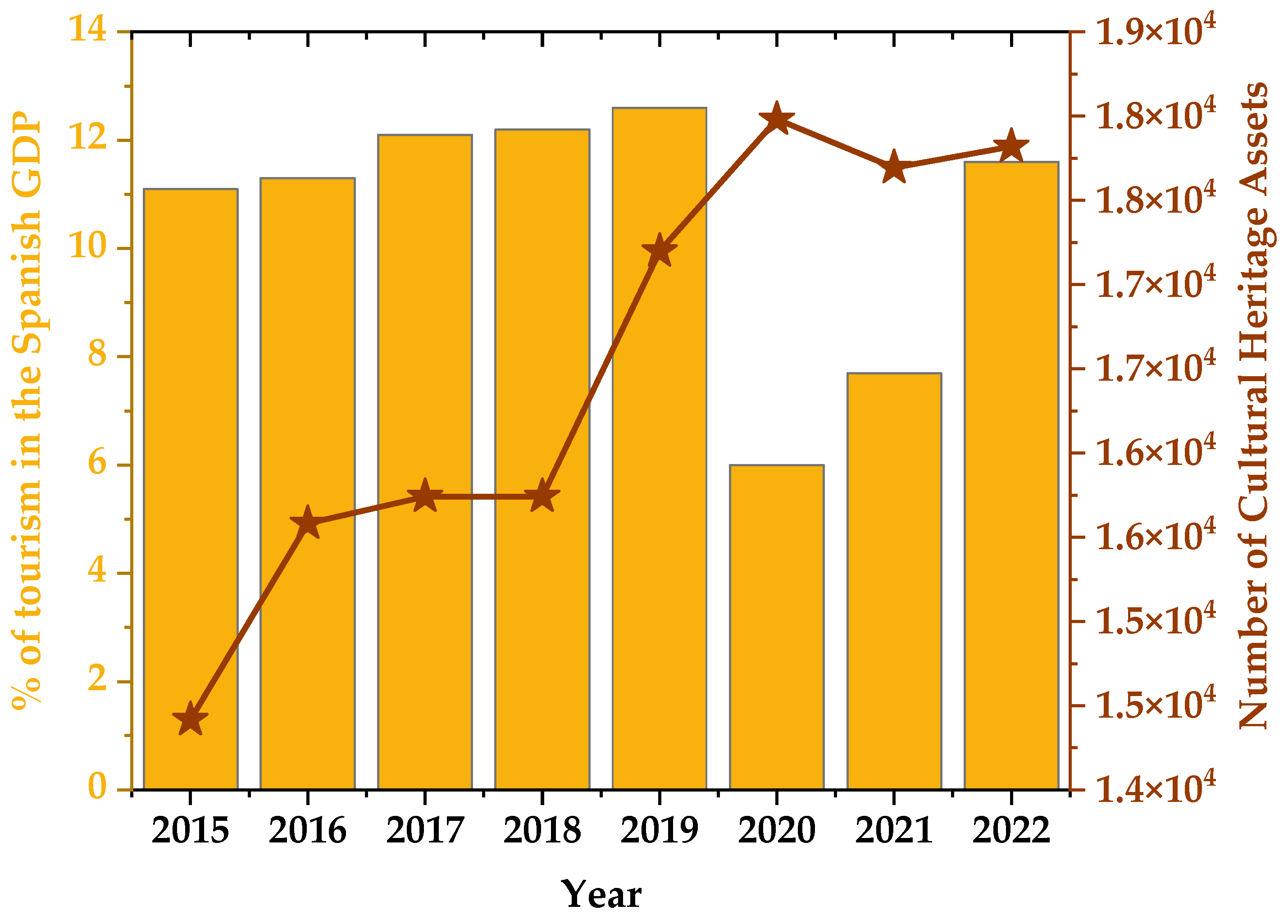


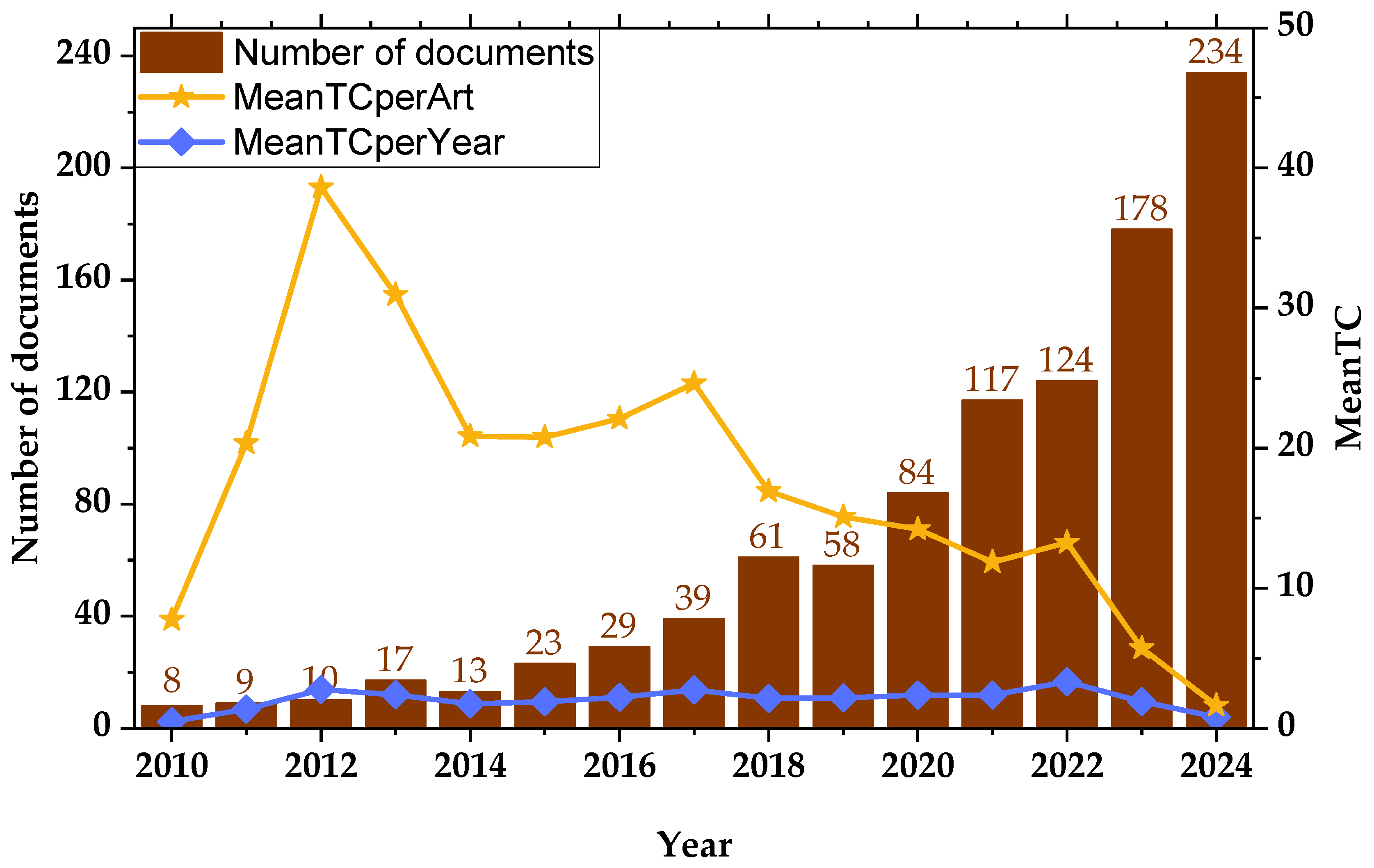
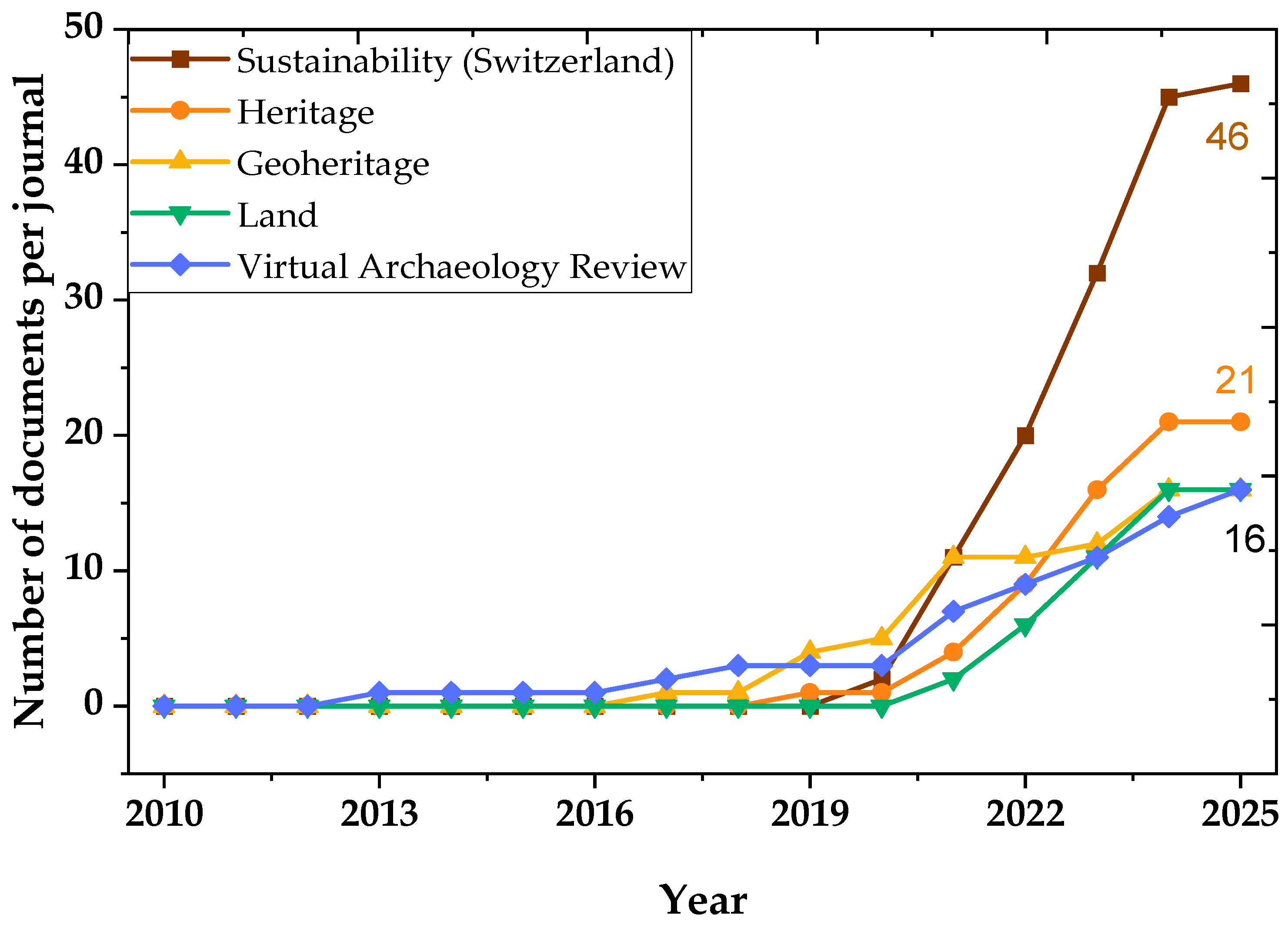
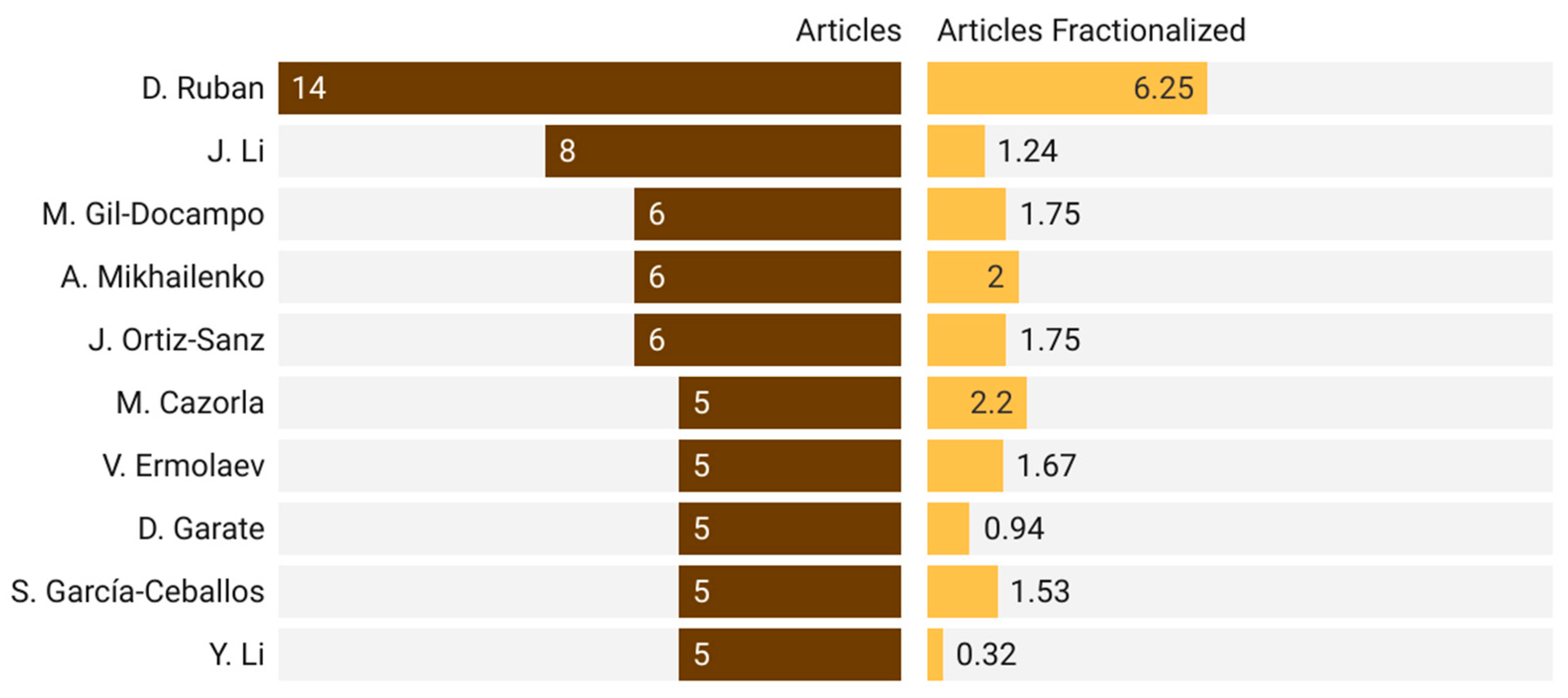
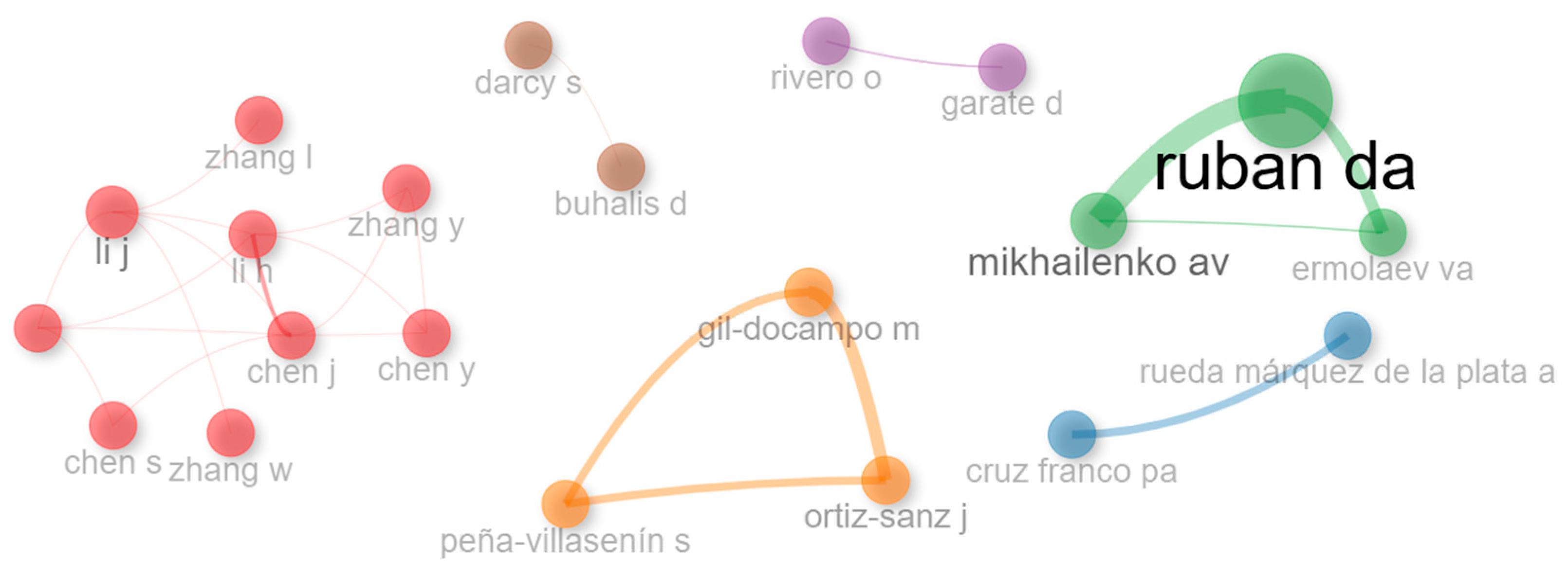
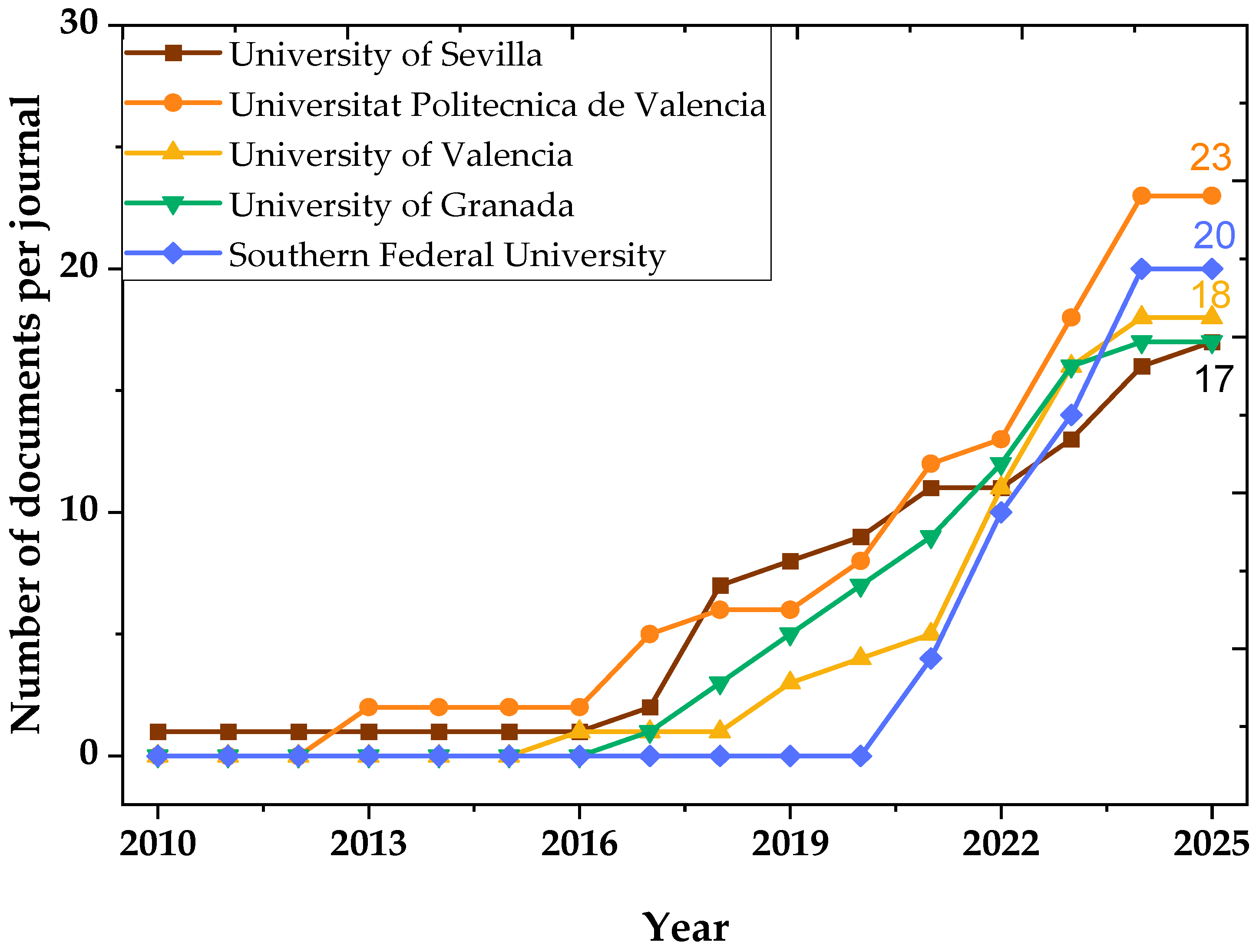
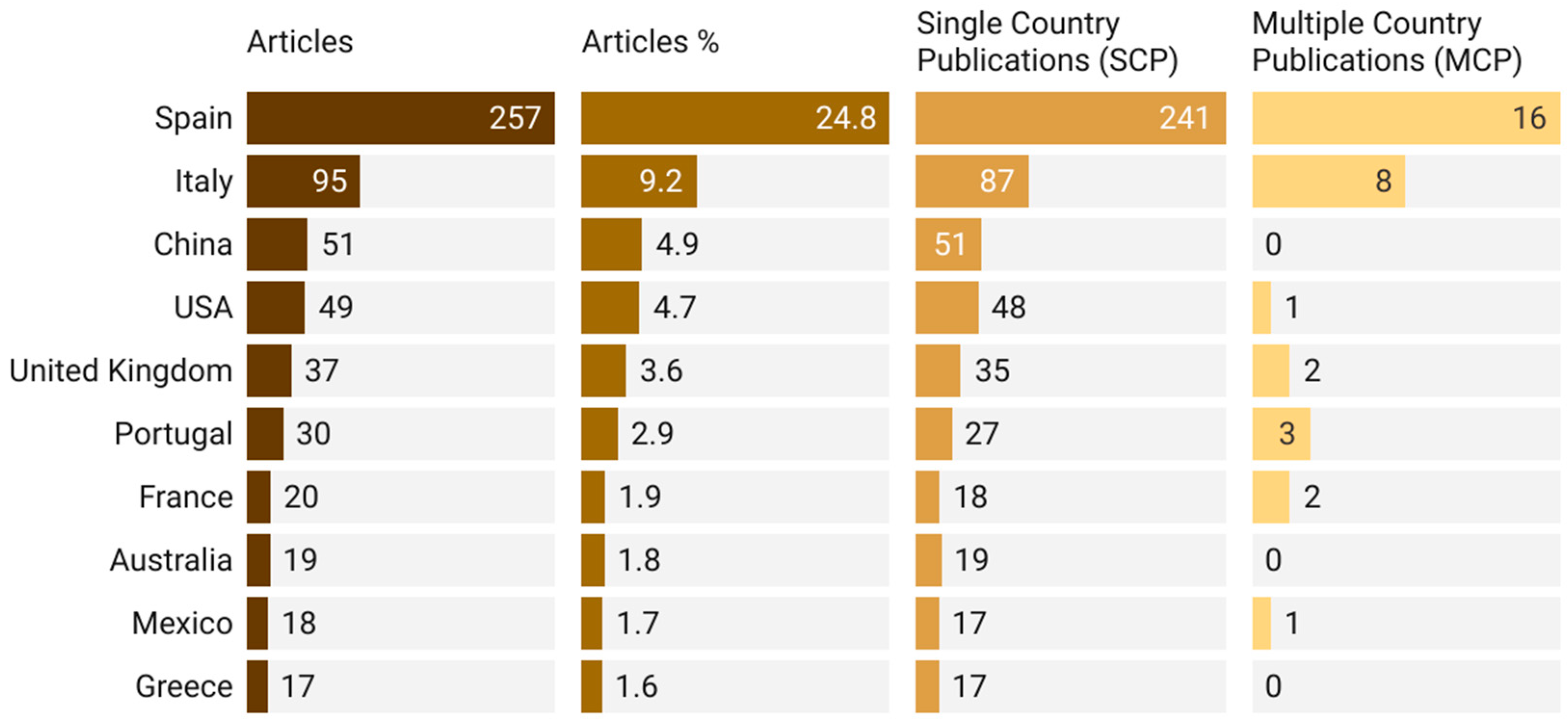
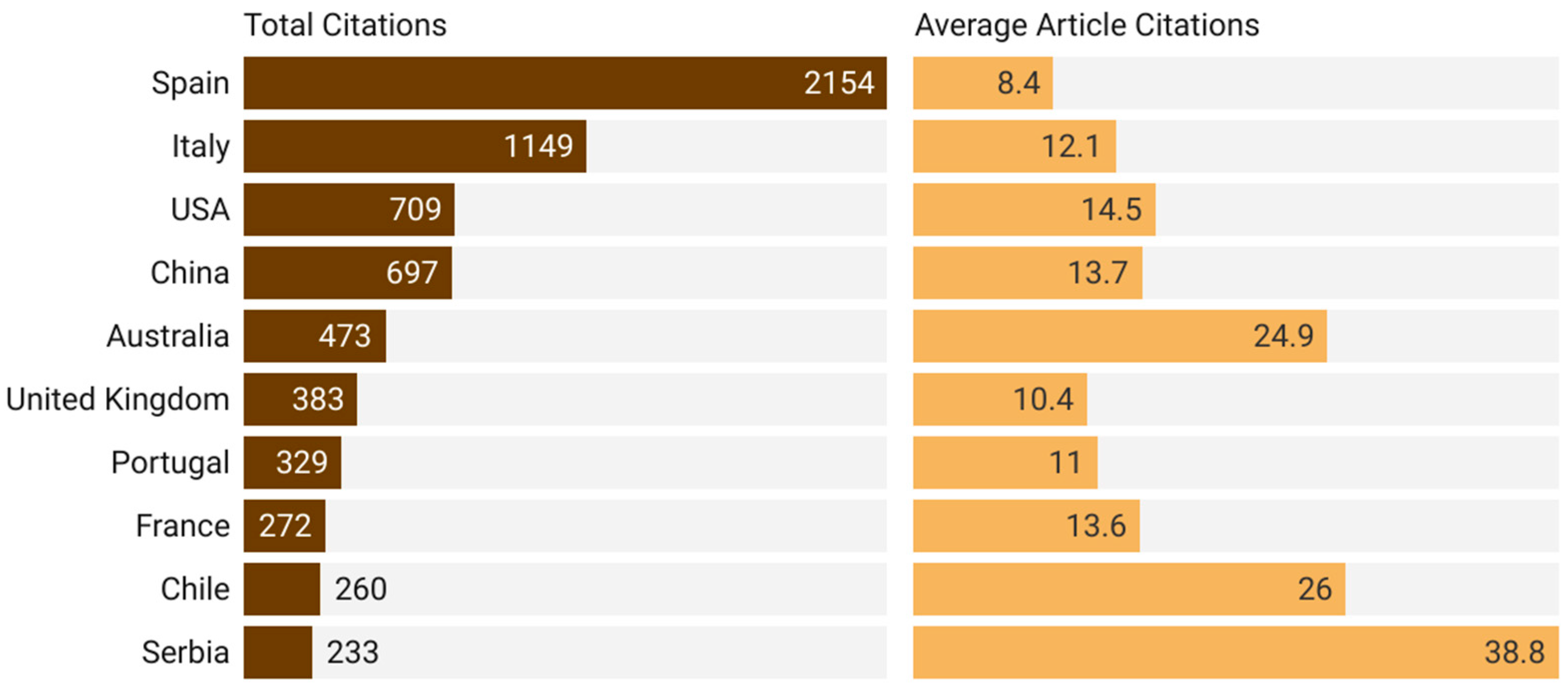

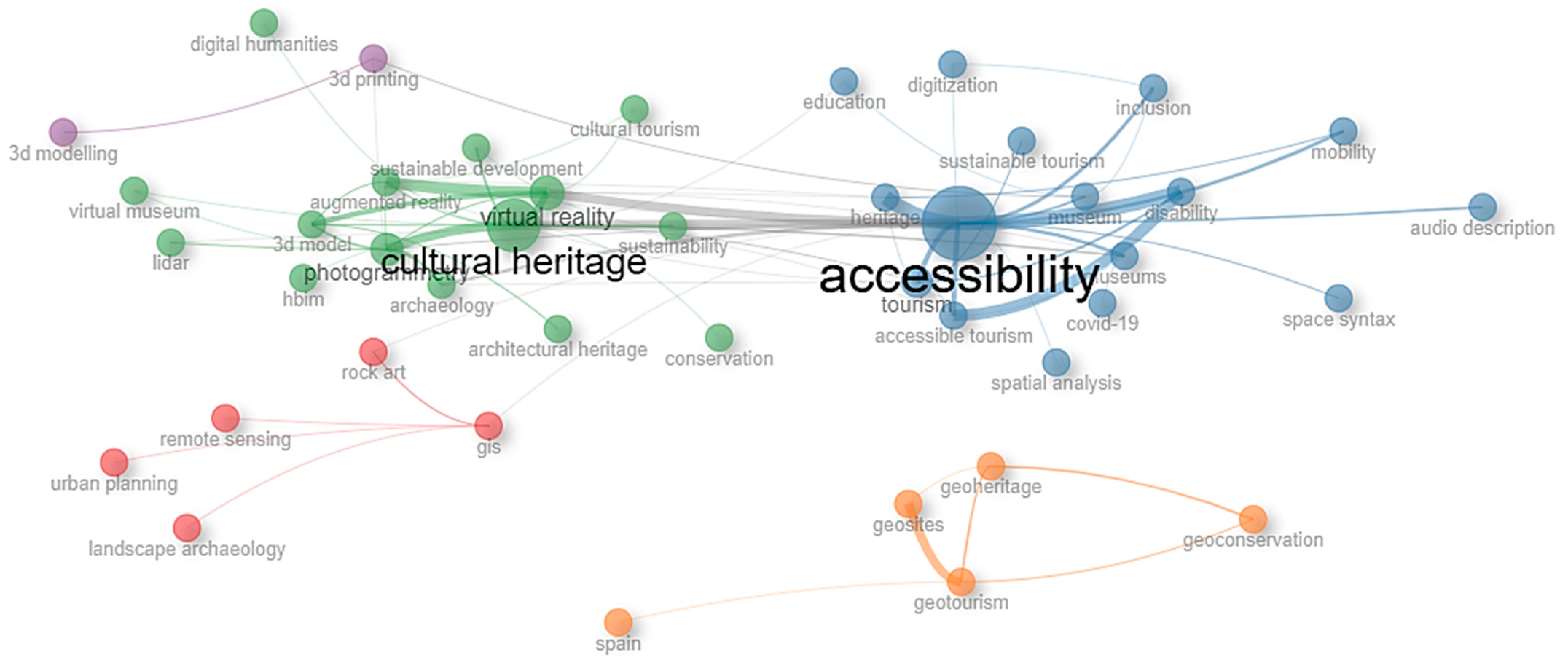
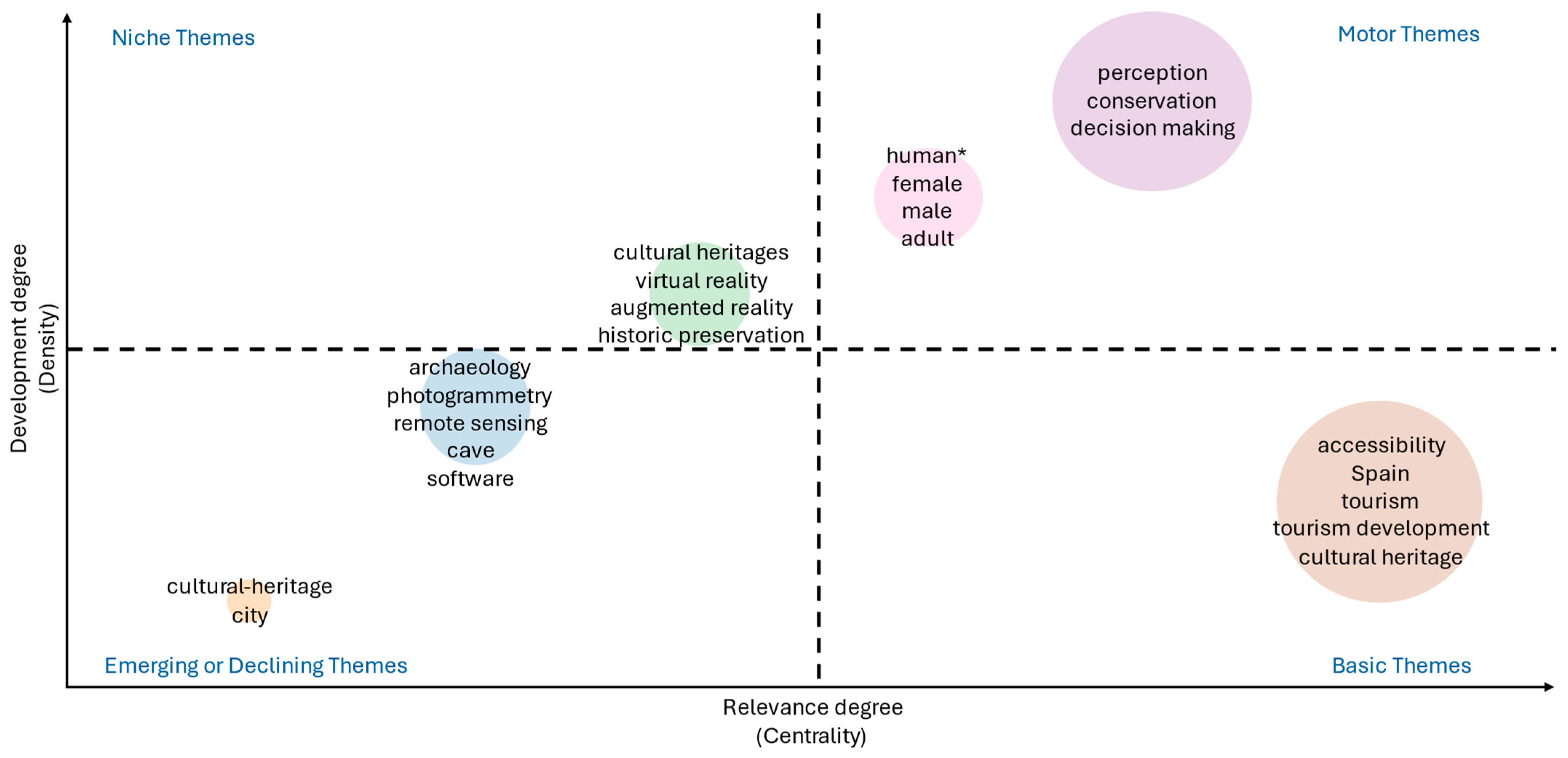
| Search String |
|---|
| (TITLE-ABS-KEY (“accessib *”) AND ALL (“univer *”) AND ALL (“Spain” OR “Spanish” OR “Iber *”) AND ALL (“cultural heritage” OR “heritage sites” OR “monument *” OR “historic * buil *”)) |
| Description | Results | Description | Results |
|---|---|---|---|
| Main information about the data | Authors | ||
| Timespan | 2010–2025 | Authors | 4083 |
| Sources (journals, books, etc.) | 599 | Authors of single-authored docs | 142 |
| Documents | 1035 | Authors Collaboration | |
| Annual growth rate % | 9.68 | Single-authored docs | 152 |
| Document average age | 4.01 | Co-authors per doc | 4.34 |
| Average citations per doc | 10.66 | International co-authorships % | 4.247 |
| Document Contents | Document Types | ||
| Keywords plus (ID) | 3524 | Article | 1034 |
| Author’s keywords (DE) | 3927 | Article; early access | 1 |
| Scientific Journal | Publisher | Quartile | Ranking | Frequency | Cumulative Frequency | Zone |
|---|---|---|---|---|---|---|
| Sustainability (Switzerland) | MDPI | Q3 (Green & Sustainable Science & Technology) | 1 | 46 | 46 | Zone 1 |
| Heritage | MDPI | Q2 (Multidisciplinary Sciences) | 2 | 21 | 67 | Zone 1 |
| Geoheritage | Springer | (Q2, Geosciences, Multidisciplinary) | 3 | 16 | 83 | Zone 1 |
| Land | MDPI | (Q2, Environmental Studies) | 4 | 16 | 99 | Zone 1 |
| Virtual Archaeology Review | Universitat Politecnica de Valencia | Q1, (Archaeology) | 5 | 16 | 115 | Zone 1 |
| Journal of Cultural Heritage | Elsevier | Q1, (Geosciences, Multidisciplinary) | 6 | 15 | 130 | Zone 1 |
| Applied Sciences (Switzerland) | MDPI | Q1 (Engineering, Multidisciplinary) | 7 | 13 | 143 | Zone 1 |
| Remote Sensing | MDPI | Q1, (Geosciences, Multidisciplinary) | 8 | 12 | 155 | Zone 1 |
| Journal of Archaeological Science: Reports | Elsevier | Q1, (Archaeology) | 9 | 11 | 166 | Zone 1 |
| Digital Applications in Archaeology and Cultural Heritage | Elsevier | - | 11 | 7 | 184 | Zone 1 |
| Scientific Journal | Hirsch Index | Egghe’s g-Index | M-quotient (m-Index) | Total Citations | Number of Articles | Article Year Start |
|---|---|---|---|---|---|---|
| Sustainability (Switzerland) | 10 | 16 | 1.667 | 360 | 46 | 2020 |
| Geoheritage | 9 | 16 | 1.000 | 260 | 16 | 2017 |
| Remote Sensing | 8 | 11 | 1.000 | 132 | 12 | 2018 |
| Journal of Cultural Heritage | 7 | 15 | 0.636 | 254 | 15 | 2015 |
| Applied Sciences (Switzerland) | 6 | 11 | 1.000 | 138 | 13 | 2020 |
| Heritage | 6 | 10 | 0.857 | 120 | 21 | 2019 |
| Journal of Archaeological Science: Reports | 6 | 11 | 0.600 | 145 | 11 | 2016 |
| Land | 6 | 7 | 1.200 | 68 | 16 | 2021 |
| Virtual Archaeology Review | 6 | 9 | 0.462 | 95 | 16 | 2013 |
| Digital Applications in Archaeology and Cultural Heritage | 5 | 7 | 0.625 | 92 | 7 | 2018 |
| Author | Hirsch Index | Egghe’s g-Index | M-Quotient (m-Index) | Total Citations | Number of Publications | First Year of Publication on Topic |
|---|---|---|---|---|---|---|
| D. Ruban | 5 | 8 | 0.714 | 78 | 14 | 2019 |
| F. P. Cruz | 4 | 4 | 1.000 | 57 | 4 | 2022 |
| R. Fort | 4 | 4 | 0.444 | 87 | 4 | 2017 |
| M. Gil-Docampo | 4 | 6 | 0.364 | 81 | 6 | 2015 |
| Y. Li | 4 | 5 | 0.800 | 66 | 5 | 2021 |
| J. Liu | 4 | 4 | 0.667 | 171 | 4 | 2020 |
| J. Ortiz-Sanz | 4 | 6 | 0.364 | 81 | 6 | 2015 |
| O. Rivero | 4 | 5 | 0.667 | 38 | 5 | 2020 |
| M. Rueda | 4 | 4 | 1.000 | 57 | 4 | 2022 |
| L. Zhang | 4 | 5 | 0.308 | 63 | 5 | 2013 |
| Ref. | Authors | Total Citations | Total Citations per Year | Normalized Total Citations |
|---|---|---|---|---|
| [38] | A. Jovanović et al. | 187 | 46.75 | 14.12 |
| [39] | I. Palomo | 178 | 19.78 | 7.23 |
| [6] | E. Michopoulou et al. | 165 | 15.00 | 7.94 |
| [40] | B. Savoldi et al. | 134 | 26.80 | 11.31 |
| [41] | J. Gao et al. | 121 | 13.44 | 4.92 |
| [42] | C. Fenu et al. | 112 | 14.00 | 6.62 |
| [43] | P.M. Da Costa et al. | 101 | 12.63 | 5.97 |
| [44] | S. Mesquita et al. | 87 | 8.70 | 3.94 |
| [45] | Y. Hou et al. | 79 | 19.75 | 5.97 |
| [46] | L. Herrero Prieto et al. | 76 | 8.44 | 3.09 |
| Keywords | Frequency |
|---|---|
| accessibility * | 92 |
| human/humans | 59 |
| Spain * | 44 |
| tourism | 36 |
| tourism development | 30 |
| cultural heritage * | 29 |
| GIS | 26 |
| sustainable development | 26 |
| ecotourism | 24 |
| female | 22 |
| male | 22 |
| tourist destination | 22 |
| perception | 21 |
| sustainability | 21 |
| tourism management | 21 |
| urban area | 20 |
| archaeology | 19 |
| heritage conservation | 18 |
| photogrammetry | 18 |
| spatial analysis | 18 |
| conservation | 17 |
| Technologies | Added Search Field | Number Results (%) |
|---|---|---|
| Immersive Visualization Tools | AND(“virtual reality” OR “VR” OR “augmented reality” OR “AR” OR photogrammetry OR “3D scanning”) | 81.01 |
| Mobile and Navigation Technologies | AND(“beacons” OR “QR code *” OR “navigation app *” OR “Bluetooth Low Energy” OR “BLE”) | 5.34 |
| Cognitive and Adaptive Accessibility Tools | AND(“Visual recognition” OR “adaptive description *” OR “sign language” OR “easy-to-read”) | 5.06 |
| Environmental Sensing and Monitoring | AND(“motion sensor *” OR “thermal imaging” OR “luminance” OR “microclimate”) | 4.92 |
| User Experience and Biometric Analysis | AND(“eye-tracking” OR “biometric *” OR “emotion recognition” OR “visitor tracking”) | 3.66 |
Disclaimer/Publisher’s Note: The statements, opinions and data contained in all publications are solely those of the individual author(s) and contributor(s) and not of MDPI and/or the editor(s). MDPI and/or the editor(s) disclaim responsibility for any injury to people or property resulting from any ideas, methods, instructions or products referred to in the content. |
© 2025 by the authors. Licensee MDPI, Basel, Switzerland. This article is an open access article distributed under the terms and conditions of the Creative Commons Attribution (CC BY) license (https://creativecommons.org/licenses/by/4.0/).
Share and Cite
del Bosque, A.; Fernández-Arias, P.; Castro-López, P.; Nieto-Sobrino, M.; Vergara, D. Universal Accessibility to Cultural Heritage in Spain: A Bibliometric Review. Buildings 2025, 15, 1563. https://doi.org/10.3390/buildings15091563
del Bosque A, Fernández-Arias P, Castro-López P, Nieto-Sobrino M, Vergara D. Universal Accessibility to Cultural Heritage in Spain: A Bibliometric Review. Buildings. 2025; 15(9):1563. https://doi.org/10.3390/buildings15091563
Chicago/Turabian Styledel Bosque, Antonio, Pablo Fernández-Arias, Patricia Castro-López, María Nieto-Sobrino, and Diego Vergara. 2025. "Universal Accessibility to Cultural Heritage in Spain: A Bibliometric Review" Buildings 15, no. 9: 1563. https://doi.org/10.3390/buildings15091563
APA Styledel Bosque, A., Fernández-Arias, P., Castro-López, P., Nieto-Sobrino, M., & Vergara, D. (2025). Universal Accessibility to Cultural Heritage in Spain: A Bibliometric Review. Buildings, 15(9), 1563. https://doi.org/10.3390/buildings15091563













